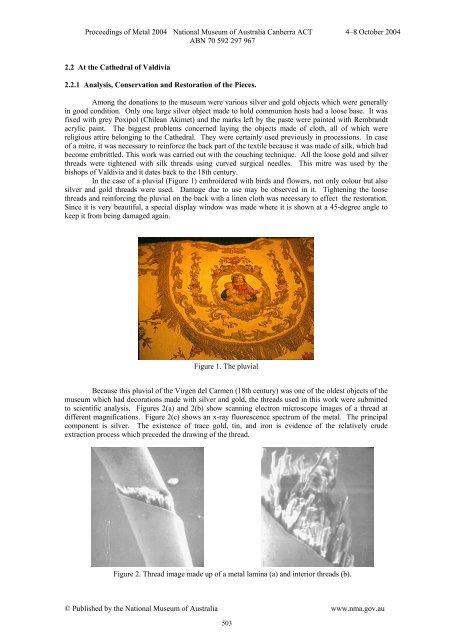Section 4: Composite artefacts (PDF 20858kb) - National Museum of ...
Section 4: Composite artefacts (PDF 20858kb) - National Museum of ...
Section 4: Composite artefacts (PDF 20858kb) - National Museum of ...
- No tags were found...
Create successful ePaper yourself
Turn your PDF publications into a flip-book with our unique Google optimized e-Paper software.
Proceedings <strong>of</strong> Metal 2004 <strong>National</strong> <strong>Museum</strong> <strong>of</strong> Australia Canberra ACT 4–8 October 2004ABN 70 592 297 9672.2 At the Cathedral <strong>of</strong> Valdivia2.2.1 Analysis, Conservation and Restoration <strong>of</strong> the Pieces.Among the donations to the museum were various silver and gold objects which were generallyin good condition. Only one large silver object made to hold communion hosts had a loose base. It wasfixed with grey Poxipol (Chilean Akimet) and the marks left by the paste were painted with Rembrandtacrylic paint. The biggest problems concerned laying the objects made <strong>of</strong> cloth, all <strong>of</strong> which werereligious attire belonging to the Cathedral. They were certainly used previously in processions. In case<strong>of</strong> a mitre, it was necessary to reinforce the back part <strong>of</strong> the textile because it was made <strong>of</strong> silk, which hadbecome embrittled. This work was carried out with the couching technique. All the loose gold and silverthreads were tightened with silk threads using curved surgical needles. This mitre was used by thebishops <strong>of</strong> Valdivia and it dates back to the 18th century.In the case <strong>of</strong> a pluvial (Figure 1) embroidered with birds and flowers, not only colour but alsosilver and gold threads were used. Damage due to use may be observed in it. Tightening the loosethreads and reinforcing the pluvial on the back with a linen cloth was necessary to effect the restoration.Since it is very beautiful, a special display window was made where it is shown at a 45-degree angle tokeep it from being damaged again.Figure 1. The pluvialBecause this pluvial <strong>of</strong> the Virgen del Carmen (18th century) was one <strong>of</strong> the oldest objects <strong>of</strong> themuseum which had decorations made with silver and gold, the threads used in this work were submittedto scientific analysis. Figures 2(a) and 2(b) show scanning electron microscope images <strong>of</strong> a thread atdifferent magnifications. Figure 2(c) shows an x-ray fluorescence spectrum <strong>of</strong> the metal. The principalcomponent is silver. The existence <strong>of</strong> trace gold, tin, and iron is evidence <strong>of</strong> the relatively crudeextraction process which preceded the drawing <strong>of</strong> the thread.Figure 2. Thread image made up <strong>of</strong> a metal lamina (a) and interior threads (b).© Published by the <strong>National</strong> <strong>Museum</strong> <strong>of</strong> Australia www.nma.gov.au503
















